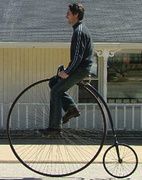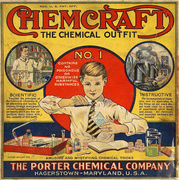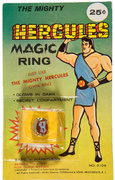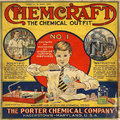Some kids like to dig in the dirt. They’ll dig up railroad spikes, old soda or beer bottles, or mysterious pieces of metal. These grimy, worn pieces of the past, discarded and buried, are treasures to an adventuring child. Someone else’s junk can light up an imagination or launch a lifelong process of discovery.
“Anytime my family goes on a road trip, we’ll all be focused on looking for old gas stations, old estates, or barns to pick.”
Part of the reason “American Pickers” is such a hit on the History Channel is that Mike Wolfe and Frank Fritz tap into that same curiosity and excitement as they drive down back roads and dig through old barns.
“I never in a million years ever imagined kids watching my show,” says Wolfe, who started picking himself at age 6. “Now we live it every day. We get mail from kids, e-mail from kids, and tons of kids coming in the shop. When me and Frank do autograph signings, parents will come up to us going, ‘Hey, my kid didn’t want to go to the Mall of America. They didn’t want to go to Disneyland. They wanted to come here and see you.'”
Inspired by his young fans, Wolfe decided to write a book called Kid Pickers: How to Turn Junk Into Treasure, due out in spring 2013. He’s also launched a site, called Kid Picker Pickin’ Post, for children ages 8 to 12 to share their discoveries, and he’s working on a “kid picker” reality show.

At top, 13-year-old James Dick shows his first pick, an electric pinball machine. Above, Robert Brickles, 17, holds a rare Gulf gasoline-pump globe meant for a boat-dock fueling station.
Here at Collectors Weekly, we launched our Show & Tell network for collectors of all ages more than two years ago. Quickly, we noticed we had teenage and preteen posters sharing their prized picks. These kids are happy to put down their cell phones and shut off their Xboxes for a chance to do exactly what Wolfe and Fritz do on the show: They’ll scout for an intriguing barn on a country road, ask their parents to pull over, and ask the owner if they can look around.
Robert Brickles, a long-time Show & Teller who is now a 17-year-old antiques dealer, became a picker after his grandfather died four years ago. Searching for mementos, he went looking through grandpa’s huge storage garage.
“I didn’t know what I was going to find,” he says. “It was fun going through the building, going through all the rooms, digging into the boxes, and finding all of the stuff. I found a Wayne Feeds thermometer, and I really liked the advertising graphics on it. I got on the computer and looked it up, but I never could find one like it.”
Soon after that, Robert’s family moved into a new house in Coshocton, Ohio, that just happened to be next to an old barn. And Robert had $100 of birthday money burning a hole in his pocket.
“I asked my neighbor if I could go through his barn,” he says. “I found a few signs there—a Red Crown porcelain sign and a Texaco sign—and I bought them with that $100 Dad gave me. That’s when it just took off. I sold the Red Crown sign for $350, and I kept the Texaco. I kept buying signs, making money. Eventually, it got to where I could keep more signs and sell less.”
Show & Teller Jamie Dick of Abingdon, Virginia, has had a similar experience with his two sons, 13-year-old James and 9-year-old Jacob. On their way to the movies, the boys spied a front yard full of stuff. “We got down the block, and they said, ‘Can we go back? We’d rather go pick his yard than go to the movies.'”

Nine-year-old Jacob Dick, with his 4-year-old sister, Aubrie, finds a container of Blockraft construction blocks.
James explains why he was so excited: “He had an old gas pump in his front yard and a Coca-Cola button and a bunch of things. We stopped and asked if we could have our pick. Well, he let us go in, and we’ve gone back multiple times now.”
The Dick boys and even their 4-year-old sister, Aubrie, got into picking because their father is a collector of coin-op machines, petroliana, and quack medical devices. Jamie would take his kids along to garage sales and flea markets, where James found a working electric pinball machine he wanted, and Jacob a tin toy military police jeep.

Jacob is drawn to old military toys, like these metal soldiers, which sparked his interest in picking.
They were hooked. They started trading yard work and snow shoveling for picking money. Jacob says, “I like how you go around and see what you can find and try to collect all these cool things. It’s like a treasure hunt.” James, in particular, loves to haggle.
“James is a good bargainer,” Jamie says. “He’s gotten some prices on things that I did not think he was going to get. I would’ve bowed down for more. He’s gotten some great deals, and that could be because he’s a kid.”
Jonas Short, 13, of Uniontown, Ohio, says he’s never asked his dad, Dave, to pull over to riffle through a stranger’s barn, but he’s been tempted to. Mostly the father-and-son team tackle tag sales, antiques shops, and yard sales. They’ve been doing this since Jonas was around 6, as he’s moved through collecting Coca-Cola bottles and advertising, military antiques, silver, coins, vinyl records, and patent medicine bottles. Now, most of Jonas’ room is lined with shelves.
“You’re always hoping for the needle in the haystack,” Jonas says. “You’re always hoping to find some little unknown shop somewhere. Or when you’re in someone’s barn or someone’s garage, you want to find that one item that’s worth $2,000 that you pick up for $5.”
That said, Jonas, who makes about $20 a month helping his parents with chores around the house, hasn’t gotten into selling, so he doesn’t worry much about what his items are worth. His dad, Dave, says it’s never been about the money for his family, as much as holding a piece of the past in their hands. Dave and Jonas felt so moved by all this history that they created their Picking and Collecting site to share their finds with the world.
“We don’t spend a whole lot of money, and I have never bought antiques specifically for their monetary value,” says Dave, a Show & Teller who collects zeppelin and blimp memorabilia. “It’s usually just something that catches my eye that’s got an interesting history to it or is different from anything I’ve seen before. Antiquing is an inexpensive thing for him and I to take off on a Saturday afternoon and spend some time together. Once we get something cool, we’ll come home and do research on it together. It’s definitely a bonding thing.”

Jonas gravitates toward patent medicine bottles. He thinks it’s “hilarious it is that people would think this single medicine can cure everything from a headache to kidney stones or pneumonia.”
Robert has also recruited his whole family—his mom, his dad, his brother and sister—to look out for barns waiting to be picked.
“You’d have to talk to maybe 500 kids on the street until you found one that likes antiques, the rusty stuff, the dusty, dirty stuff.”
“Anytime we go on a road trip, that’s all we’ll be focused on, looking out the window, looking for old estates, old barns, old gas stations, stuff like that,” he says. “I’ll just walk up, knock on the door, and tell them I noticed something out in the yard and try to spark up a conversation, then ask if anything’s for sale. Probably six out of 10 people will let me come look around. Most people are real friendly. I end up at a lot of older people’s houses. It’s usually a little bit easier for them to sell stuff when they realize I have the same interest that they have.”
Robert is willing to pay good money for a real deal, as much as $10,000. That’s a shocking amount of cash for a 17-year-old to have on hand. But Robert, who just opened his own store, Around the Corner Antiques, in his new town of Florala, Alabama, says his research and persistence have paid off.
“Most teenagers, when they get money, the first thing they want to do is spend it,” he says. “I save my money and just wait for something good to come along so that when I need the money I have it. None of this is money that my parents have given me. Any dime I have, I made it myself.”

This year, Robert opened his own business, Around the Corner Antiques in Florala, Alabama, at age 17.
What Robert didn’t realize at first is that his old hometown of Coshocton, Ohio, is a particularly ripe town for picking: At the turn of the century, two local newspaper publishers, Jasper Meek and H.D. Beach, developed lithographed tin advertising signs. Thanks to his picking adventures, Robert even met the son of an H.D. Beach employee, and learned from him how to identify authentic antique porcelain signs from the fakes.
“At first—I’ll be honest—all I wanted was the stuff, the signs” he says. “I didn’t even know that my own hometown was where the manufacturing companies were. But once I found that, then it changed and I was more interested in the history than I was directly in what I was buying or collecting.”
For Jonas, American history became personal when his grandma gave him a helmet liner from the Korean War era at age 6, which sparked his interest in military antiques and the stories of his family members who served in different wars.
“The helmet had always been something her children and her grandchildren like me had played with,” he says. “I think if I hadn’t developed such a connection to military things, in history class, I would look like the other kids and go, ‘Oh, yes, World War II, whatever. Let’s learn about something fun.'”

Dave Short and his son, Jonas, researched this trunk they thought was from the U.S. military and discovered it was from the Civilian Conservation Corps. “That was a neat learning experience,” Dave says.
Jonas, like Robert, often ends up having long, in-depth conversations with elderly folks in his community.
“We got down the block, and my kids said, ‘Can we go back? We’d rather pick his yard than go to the movies.'”
“I try to get them to talk about their childhood or what it was like growing up when gas was 5 cents a gallon instead of $4 a gallon, when you could buy a cup of Joe for 2 cents instead of $2. I’ll ask them about the item I’m buying. I’ll say, ‘Hey, did you get this on a trip to another country?’ and they’ll say, ‘Oh, yes, that was on our honeymoon.’ Then, here’s a whole story behind it, not just that it was inherited from your grandparents.”
Mike Wolfe says he believes, “Every kid is a picker early in life. Every kid has a sense of adventure, the curiosity, wanting to discover. As you get older, you can lose it.”
However, that childhood desire to find treasures in the dirt doesn’t necessarily translate to real antiquing. Robert, who used to play football in Ohio, says most of his friends in high school don’t get into picking the way he does. Jonas and James have had similar experiences at their middle schools.

“American Pickers” star Mike Wolfe poses with two young aspiring collectors. Via his Facebook page.
“Most people in my grade don’t really have or care about old stuff at all,” James says. “When we start a conversation about it, they just tune out. They’re more addicted to Xbox and cell phones.”
His dad, Jamie, corrects him with a laugh, “Now, listen, you. You’re the same way.”
But modern technology can help young collectors, too. Jonas uses his smart phone to look up antiques and eBay prices when he’s out picking. Other than that, he’s not that interested in social networking.
“I try to get on Facebook and do stuff that the other kids are doing,” Jonas says. “But I’d much rather walk through an antiques shop all day than be sitting down on Facebook, chatting with a friend.”
Even though Robert isn’t particularly interested in spending hours online either, the Internet helped him to connect with other teens like him, through sites on oil and gas antiques and the like. He says he’d love to see an online community specifically designed to bring teenage collectors across the U.S. together.
“If younger collectors realize that there are more people out there like them, I think they’d be more likely to do it,” he says. “They’d say, ‘This is normal; other people are doing this.’ Most collectors right now are older people. You see some kids, but you don’t see a lot that get really into it, that get hooked on it, who can’t stop.”
Jonas agrees. “I would totally love something like that because if you talk to any kid on the street, you would have to talk to maybe 500 until you find one that liked antiques, that liked vintage stuff, the rusty stuff, the dusty, dirty stuff.”

Jonas picked this antique mechanical bank, which takes your nickels, dimes, and quarters, and adds them up.
And he could offer tidbits of advice to other young collectors like this one: “Always keep an inventory of what you have,” Jonas says. “I learned that the hard way multiple times, looking for something and not knowing where it is. I’ve been putting little labels in a little notebook, and I’ve been numbering all my items and what I paid.”
Even Robert admits he’s had this trouble. “Sometimes I’ll even go through boxes and be looking for oil cans and I’ll find a sign or something that I didn’t even realize I had.”
As an antiques dealer, Robert says, it would benefit him if there were less collectors competing with him for killer finds. Then again, if there weren’t any collectors—he’d have no one to sell to. Ultimately, though, he feels that fostering the next generation of collectors is important for the preservation of historical artifacts.
“Once the older generation dies off, who is going to come around and buy this stuff?” he says. “You need more people to start collecting at younger ages so the cycle keeps repeating itself. If we don’t preserve this stuff, then one day it’s going to be no more. Take the sign industry in Coshocton, slowly, people are forgetting about it. That’s something that should be in everyone’s minds and taught in school, the history of American manufacturing.”








 Cyanide, Uranium, and Ammonium Nitrate: When Kids Really Had Fun With Science
Cyanide, Uranium, and Ammonium Nitrate: When Kids Really Had Fun With Science
 American Picker Dream, Part I: Mike Wolfe On His Love Affair With Bikes
American Picker Dream, Part I: Mike Wolfe On His Love Affair With Bikes Cyanide, Uranium, and Ammonium Nitrate: When Kids Really Had Fun With Science
Cyanide, Uranium, and Ammonium Nitrate: When Kids Really Had Fun With Science Toys That Were Made to Be Broken
Toys That Were Made to Be Broken Mari Tepper: Laying it on the Line
Mari Tepper: Laying it on the Line Nice Ice: Valerie Hammond on the Genteel Charm of Vintage Canadian Costume Jewelry
Nice Ice: Valerie Hammond on the Genteel Charm of Vintage Canadian Costume Jewelry How Jim Heimann Got Crazy for California Architecture
How Jim Heimann Got Crazy for California Architecture Modernist Man: Jock Peters May Be the Most Influential Architect You've Never Heard Of
Modernist Man: Jock Peters May Be the Most Influential Architect You've Never Heard Of Meet Cute: Were Kokeshi Dolls the Models for Hello Kitty, Pokemon, and Be@rbrick?
Meet Cute: Were Kokeshi Dolls the Models for Hello Kitty, Pokemon, and Be@rbrick? When the King of Comedy Posters Set His Surreal Sights on the World of Rock 'n' Roll
When the King of Comedy Posters Set His Surreal Sights on the World of Rock 'n' Roll How One Artist Makes New Art From Old Coloring Books and Found Photos
How One Artist Makes New Art From Old Coloring Books and Found Photos Say Cheese! How Bad Photography Has Changed Our Definition of Good Pictures
Say Cheese! How Bad Photography Has Changed Our Definition of Good Pictures Middle Earthenware: One Family's Quest to Reclaim Its Place in British Pottery History
Middle Earthenware: One Family's Quest to Reclaim Its Place in British Pottery History Fancy Fowl: How an Evil Sea Captain and a Beloved Queen Made the World Crave KFC
Fancy Fowl: How an Evil Sea Captain and a Beloved Queen Made the World Crave KFC
So happy to see that kids are starting to collect, and learn something about fun. I always loved to explore the junk for finds when I was a kid. It has been looking pretty bleak for so many years.
Thanks Lisa. You were right, I did enjoy reading this article. Even though I hate rust I too am a picker at heart and am glad to see that our hobby also has a bright future.
Really enjoyed this article – very inspirational young-uns and young adults – also seem grounded : )) – keep it up.
Excellent article and great to see a new generation of collectors and decent kids too!
What a great article.
I love kids picking! God Bless America……….
My 12 year old son, Burke, has been picking his entire life! As the grandson of 2 past ACGS Presidents, it must be in his blood:) He is well known at a local flea market, and his goal is to have his own shop. Thank you to all of the collectors who treat him seriously and give him the respect he deserves! If parents would take the time, they might all be surprised how quickly the kids put down the cell phone and video games to do the same.
Love this article!
Hey guys! I’m from Brazil and I love antiques ad board signs and antique coke products! Here is very difficult to find these items. In the end of july I’m going to New York, does someone knows some places where I can find some items like those? Especially items about advertising, signs, objects of beer, coke, pepsi and oil. I’d like to decor my bar and garage. If somene can help me, I thank you! (Sorry about my English!)
Great to see some younger people learning about and collecting antiques and collectables no matter what they collect
I hope my children follow in our footsteps.
Great article!
Chris A. Hughes
A Nerd’s World
Wow, what a great article. I love these collectors and their collections. Keep ’em going Kids!
Just tripped over this and it reminded me of my dislike of those two american picker guys. They started off like the rest of us but once a little fame hit them they basically had people give them stuff, in return for ten cents worth of media fame, which they then sold to make a proverbial fortune. That wasn’t picking, it’s was ripping off people. These kids have it right, keep it as a hobby and go from there.